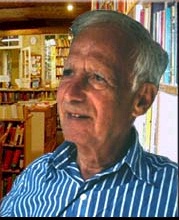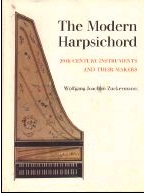
Wolfgang Zuckermann
Encyclopedia

Harpsichord
A harpsichord is a musical instrument played by means of a keyboard. It produces sound by plucking a string when a key is pressed.In the narrow sense, "harpsichord" designates only the large wing-shaped instruments in which the strings are perpendicular to the keyboard...
maker, author and environmental and social activist. He was born in Berlin, became an American citizen in 1938 and has lived in France since 1995.
He saw front line action as a Private with the U.S. Army and followed this by obtaining a BA in English and psychology from Queens College, New York, winning the title of Queens College Scholar, the highest honor conferred upon graduates at that institution.
Zuckermann as harpsichord builder
After a stint as a child psychologist, Zuckermann, an amateur musician, became one of the first harpsichord makers in the United States and in the late 1950s invented the "do-it-yourself" harpsichord kit, sometimes called the 'Model T' harpsichord, which he sold in large quantities to institutions, professionals, and individuals around the world, thus fundamentally transforming a significant part of the world musical scene.The harpsichord kit was produced in Zuckermann's New York workshop on Christopher Street in Greenwich Village
Greenwich Village
Greenwich Village, , , , .in New York often simply called "the Village", is a largely residential neighborhood on the west side of Lower Manhattan in New York City. A large majority of the district is home to upper middle class families...
. It was designed to maximize affordability, and therefore made extensive use of parts ordered out of stock from other manufacturers, including whole keyboards. It was also designed to be assembled by amateurs, which was one factor in using (initially) a straight piece where most harpsichords employ a curved bentside.
Even though the keyboard more resembled that of a piano and its soundboard was made from laminated wood, Zuckermann's harpsichord became one of the most popular harpsichord models ever; it was assembled by people of all ages and given affectionate nicknames such the "Slantside" or the "Z-box".
Initially the wooden pieces for the case, along with some other commonly available parts, were not included, so the price was set at a most economical $150. Little by little, the Zuckermann kit became more elaborate and complete. By the mid 1960's unassembled cases consisting of carefully cut unfinished wood of various kinds could be purchased optionally. Other instrument kits were also made available, including a spinet
Spinet
A spinet is a smaller type of harpsichord or other keyboard instrument, such as a piano or organ.-Spinets as harpsichords:While the term spinet is used to designate a harpsichord, typically what is meant is the bentside spinet, described in this section...
harpsichord and a clavichord
Clavichord
The clavichord is a European stringed keyboard instrument known from the late Medieval, through the Renaissance, Baroque and Classical eras. Historically, it was widely used as a practice instrument and as an aid to composition, not being loud enough for larger performances. The clavichord produces...
.
Zuckermann wrote of his project as follows: "I thought of the harpsichord kit idea in 1959, when I received too many service calls on the finished instruments we were then producing, and I wanted to let my customers into the secret of how to make these instruments. My original kit was a straight-sided, single set of strings harpsichord, then selling for $150: we supplied the essential parts, but the customers had to shop for the wood. We soon added the case for another $150 and this became very quickly a big seller."
The Modern Harpsichord

Historically informed performance
Historically informed performance is an approach in the performance of music and theater. Within this approach, the performance adheres to state-of-the-art knowledge of the aesthetic criteria of the period in which the music or theatre work was conceived...
", Zuckermann's own tastes as revealed in this book tended sharply toward authenticity, particularly toward work that attempted to recreate instruments of the kind built by the great makers of the past, using lightweight construction and preindustrial materials. This taste was manifested in the book's detailed, warmly appreciative account of the work of three builders in particular, Frank Hubbard
Frank Hubbard
Frank Twombly Hubbard was an American harpsichord maker, a pioneer in the revival of historical methods of harpsichord building.-Student days:...
, William Dowd
William Dowd
William Richmond Dowd was an American harpsichord maker and one of the most important pioneers of the historical harpsichord movement....
, and Martin Skowroneck. It is also seen in Zuckermann's relatively caustic treatment of the major firms of the time, who were still building heavily designed, ahistorical instruments. The subsequent history of harpsichord building has evidently vindicated Zuckermann's views, as authentically-oriented harpsichords now dominate the field.
In 1969, Zuckermann sold his harpsichord business to David Jacques Way
David Jacques Way
David Jacques Way was an American harpsichord maker.-Early life:Born in Elk Creek, Nebraska, Way was educated at Black Mountain College in North Carolina in its earliest days, where he gained his lifelong interest in graphic design and typography...
. Way had been the publisher of The Modern Harpsichord. and become an enthusiast for harpsichord building in the process. Way shifted the firm's productions in the direction of more historically authentic instruments, making use of Zuckermann's research. The company continues in business today.
Zuckermann as activist
In 1969, Zuckermann, in despair over US involvement in Vietnam, left New York to live first in England, and later in France. He played an active part in creating small local collaborative projects that cut away from the values and patterns of the dominant consumer society. While living in London, he noted the five hundred mews (former stable blocks) in that city as, contrary to professional planning views at the time, a viable city environment, and proceeded to write with co-author Barbara Rosen The Mews of London: A Guide to the Hidden Byways of London's Past(Webb & Bower, London, 1982, ISBN 0-03-062419-3)In 1987 Zuckermann began his collaboration with The Commons, an independent non-profit policy research group based in Paris. Through 1994 he was a Senior Associate, writer and editor of a program called the New Mobility Agenda which looks at ways in which we could arrange our transportation (and our lives) so that people could obtain better access to the places they live and work. The project eventually led to a search for ideas, suggestions, and possible solutions from people and places around the world. Zuckermann's significant experience as a 'kit builder' on a large international scale has also been one of the important driving forces behind the program and its various spin-offs and demonstration projects.
End of the Road (ISBN 0-930031-46-6, Chelsea Green Pub Co, Post Mils, Vermont, November, 1991) was written as an attempt to pull together all the rich body of information and ideas being generated by the New Mobility project, in an easily readable form, addressed to the general public, and put into jargon-free and vivid language not generally found in the transportation literature. Zuckermann has followed this up with a number of other EcoPlan projects such as co-author of a children's book, Family Mouse Behind the Wheel, James Clarke & Co Ltd, London UK, September 30, 1992, ISBN 0-7188-2834-8, as well as taking a leading role in The Commons Car Free Days program. His book, Alice in Underland, The Olive Press (January 10, 2000), ISBN 2-9514588-0-0, looks at today's technology and society matters (and manners) from a perspective somewhat different from that usually encountered in the literature.
In 1994 Zuckermann got together with Eric Britton
Eric Britton
Francis Eric Knight Britton is an American Political Scientist and Sustainability Activist who has lived and worked in Paris, France since 1969. As the main convenor of The Commons: Open Society Sustainability Initiative and its various networks, he is well known for promoting integrated public...
to create an interactive program under The Commons for something they called "Consumer Holiday – The one day a year we turn off the economy and think about it". Shortly however they became aware of a well financed Canadian program with many of the same objectives, Buy Nothing Day
Buy Nothing Day
thumb|Buy Nothing Day demonstration in [[San Francisco]], November 2000Buy Nothing Day ' is an international day of protest against consumerism observed by social activists. Typically celebrated the Friday after American Thanksgiving in North America and the following day internationally, in 2011...
, and then decided to convert their collaborative project international an international support site that looked at a rather broader range of problems, ideas, paths and solutions, which would help to amplify and compete the Canadian project. Thus the International Buy Nothing Day program was born and continues to this day.
Zuckermann currently continues his research, writing, and editing activities with The Commons and is in parallel founder and owner-manager of Shakespeare, a bookstore and arts center in Avignon which resolutely refuses the separation of "culture" from the issues of technology, society and personal responsibility.
External links
- http://zhi.net/ – Zuckermann Harpsichords
- A legend in his own lifetime – with recent photos
- An introductory letter by Wolfgang Joachim Zuckermann to Marc Ducornet's business 'The Paris Workshop' – gives a summary of his career as a harpsichord maker
- Wolfgang's Jacks – The harpsichord jacks collected from makers around the world for his 1969 book.

